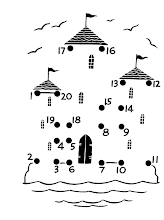Luc Tuymans is a Belgian oil painter who is very similar to Gerhard Richter, another favorite of mine, in that he employs a photographic style. Though not so much photorealistic as it is loosely representational, his compositions are photographic in nature. He uses published photographs as source material; the work is a fine example of an artist who is very inspired by cinematography and photography. Note the blatant cropping of images, much like a photograph. Tuymans has a background in film, which explains the "fade-out" technique in some of his paintings that are very much like fade-outs in film. The unusual perspectives also give the viewer the impression that the subject matter is viewed from behind the lens of a camera. He tends to paint ordinary parts of a whole, like a knee, resulting in the idea that it is viewed with a zoom lens.
The subject-matter is intense, as his work is inspired by controversial issues such as the infamous political and religious figures, the sexual abuse of children, and harrowing periods in history such as the Holocaust. In one series of work, Der Diagnostische Blick from 1992, he painted portraits of patients with various ailments taken from photographs in a medical textbook. Emotion and sentimentality is very far-removed from the subject-matter, however. It is very apparent that his view of his subject-matter is cold, clinical, and detached. He even stated himself that, "Anything banal can be transformed into horror. Violence is the only structure underlying my work".
Tuymans' mark-making is very unique. He uses short, punctuated brushstrokes that are not dramatic or broad, but they result in a painterly style that has movement and makes his paintings vibrate with tense energy. He uses a neutral color palette that is monochromatic. The palette itself is very modern to me- clean and almost sterile. His colors are mostly low-key, and the hues are greyed down and muted. The strange tinge of color in his paintings and their washed-out quality stems from the effect of artificial lighting that is used in film and photography.
Dildo, 1996
Suicide, 1975
The Cry, 1989
This one reminds me a lot of Elmer Bischoff.
Intolerance, 1993
Very reminiscent of Giorgio Morandi, another favorite of mine.
Silent Music, 1992
This is a good example of the haunting quality of his work. This is a painting of a child's room, painted with pinks and blues. However, there is not evident sign of a child living there; the light source is not clearly defined, and the perspective gives the impression that the room is being looked on by an intruder. The hard angle of the shadow cast by the high chair is unsettling
---
I have a Phaidon Press book on Luc Tuymans if anyone wants to borrow it. Given that you will return it to me, of course. :)
Love to all,
Jennifer


No comments:
Post a Comment